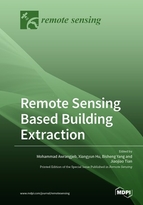Remote Sensing based Building Extraction
A special issue of Remote Sensing (ISSN 2072-4292). This special issue belongs to the section "Urban Remote Sensing".
Deadline for manuscript submissions: closed (31 October 2019) | Viewed by 117631
Special Issue Editors
Interests: deep learning; remote sensing image processing; point cloud processing; change detection; object recognition; object modelling; remote sensing data registration; remote sensing of environment
Special Issues, Collections and Topics in MDPI journals
Interests: feature extraction; computer vision; pattern recognition; LiDAR data processing; machine learning
Interests: laser scanning; mobile mapping; UAV mapping; point cloud processing; 3D scene understanding; GIS applications
Interests: forest remote sensing building extraction; 2D/3D change detection; data fusion; time-series image analysis; semantic 3D point cloud segmentation; computer vision; 3D reconstruction
Special Issues, Collections and Topics in MDPI journals
Special Issue Information
Dear Colleagues,
The rapid growth of sensor technologies, such as airborne and terrestrial laser scanning, and satellite and aerial imaging systems, poses unique challenges in the detection, extraction and modelling of buildings from remote sensing data. In fact, building detection, boundary extraction, and rooftop modelling from remotely-sensed data are important to various applications, such as the real estate industry, city planning, homeland security, automatic solar potential estimation, and disaster (flood or bushfire) management. The automated extraction of building boundaries is a crucial step towards generating city models. In addition, automatic building change detection is vital for monitoring urban growth and locating illegal building extensions.
Despite the fact that significant research has been ongoing for more than two decades, the success of automatic building extraction and modelling is still largely impeded by scene complexity, incomplete cue extraction and sensor dependency of data. Vegetation, and especially trees, can be the prime cause of scene complexity and incomplete cue extraction. The situation becomes complex in hilly and densely-vegetated areas where only a few buildings are present, these being surrounded by trees. Important building cues can be completely or partially missed due to occlusions and shadowing from trees. Trees also change colors in different seasons and may be deciduous. Moreover, image quality may vary for the same scene even if images are captured by the same sensor, but at different dates and times. Thus, when the same detection and modelling algorithms are applied to two different sets of data of the same scene, the outcomes may well be different. Particularly, small building structures, such as garden sheds and roof planes, are often missed in low-resolution data. The automatically-generated models either require significant human interaction to fix inaccuracies (as a post-processing step) or are useless in practical applications.
Therefore, intelligent and innovative algorithms are in dire need for the success of automatic building extraction and modelling. This Special Issue will focus on the newly-developed methods for classification and feature extraction from remote sensing data and will cover (but is not limited to) the following topics:
- Aerial and satellite data collected from different sensors (VHR, hyperspectral, SAR, LiDAR, UAV, thermal imagery, oblique imagery, etc.);
- Data analysis and data fusion for building detection, boundary extraction, rooftop modelling, and change detection;
- Data analysis and data fusion for land cover classification (semantic segmentation, buildings/roads extraction, vehicle detection, land use/cover mapping, etc.).
Moreover, we cordially welcome application papers, including change detection, urban growth monitoring, disaster management, and technical reviews.
Dr. Mohammad Awrangjeb
Prof. Xiangyun Hu
Prof. Bisheng Yang
Dr. Jiaojiao Tian
Guest Editors
Manuscript Submission Information
Manuscripts should be submitted online at www.mdpi.com by registering and logging in to this website. Once you are registered, click here to go to the submission form. Manuscripts can be submitted until the deadline. All submissions that pass pre-check are peer-reviewed. Accepted papers will be published continuously in the journal (as soon as accepted) and will be listed together on the special issue website. Research articles, review articles as well as short communications are invited. For planned papers, a title and short abstract (about 100 words) can be sent to the Editorial Office for announcement on this website.
Submitted manuscripts should not have been published previously, nor be under consideration for publication elsewhere (except conference proceedings papers). All manuscripts are thoroughly refereed through a single-blind peer-review process. A guide for authors and other relevant information for submission of manuscripts is available on the Instructions for Authors page. Remote Sensing is an international peer-reviewed open access semimonthly journal published by MDPI.
Please visit the Instructions for Authors page before submitting a manuscript. The Article Processing Charge (APC) for publication in this open access journal is 2700 CHF (Swiss Francs). Submitted papers should be well formatted and use good English. Authors may use MDPI's English editing service prior to publication or during author revisions.
Keywords
- Building detection
- Building extraction
- Roof reconstruction
- 3D building modelling
- Building change detection
- Remote sensing data
- LiDAR
- VHR
- Hyperspectral imagery
- Multispectral imagery
- SAR
- Data fusion
- point cloud
- Aerial imagery
- Satellite imagery







